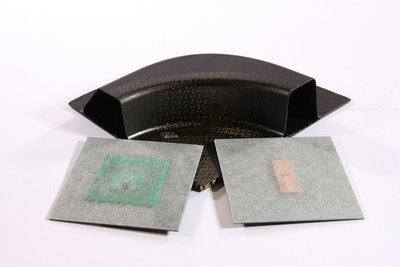Using RFID for fibre composites
It is barely visible to the naked eye: the work pieces in the production hall look normal. But the first impression is deceiving. The aeroplane components are intelligent and can communicate with the skilled workers in their vicinity. Not only can they tell them what they are, they can also provide information on who has worked on them as well as on the next work step. An RFID chip transmits the information. It measures just a few square millimetres and transmits details about the component quickly, efficiently and consistently to a receiver via radio. Until now, only a handful of companies have been using the technology for documentation purposes in production processes. Most often, RFID is used for access control purposes, or to record time, for instance on employee smart cards.
How well an RFID transponder works depends mainly on the material that surrounds it. The material can have a negative influence on the transponder antenna’s range, as well as on the quality of data transmission. Researchers at the Fraunhofer Institute for Integrated Circuits IIS in Nuremburg have now developed an RFID transponder with an antenna that works reliably on fibre composites. Components such as glass or carbon fibres are both lightweight and robust, and are thus used increasingly in aircraft and vehicle production. However, these fibres have a particularly strong influence on radio frequencies. Until now, their exact behaviour with regard to RFID has not been well known, and this is why production steps are still documented with a pencil and paper.
“We took a close look at the frequencies relevant to RFID technology: 125 kHz (LF: low frequency), 13.56 MHz (HF: high frequency), and 868 MHz (UHF: ultrahigh frequency). We measured the extent to which glass and carbon fibres affect the reliability of the transponder,” says Tobias Dräger, an engineer, in describing the work of the IIS team.
The result was that while LF, HF and UHF work well with glass fibres, they showed weaknesses with carbon fibres. At high frequencies in particular, the carbon fibres compromised the performance of the RFID chip significantly.

“Carbon fibres are, similarly to metal, conductive. As a result, they dampen radio signals considerably - especially at 868 MHz,” says Dräger’s colleague Dr Iker Mayordomo.
But thanks to their relatively large range of up to 15 m, UHF frequencies are very well suited to applications in logistics and production. In the past, if RFID was used with incompatible materials such as metals, a very expensive transponder was required to reach this level of performance.
“The antennas and transponders required make these customised systems very large. At the same time, integrating them into fibre composites is difficult,” says Dräger in discussing the initial situation. Together with partners from the aviation industry and research, his team has successfully developed a transponder that can operate reliably within conducting components, which are also subject to physical stress. The scientists have designed an ultrathin antenna that can be embedded in materials underneath a protective glass fibre layer. Together with Schreiner LogiData, a manufacturer of RFID transponders, IIS has already developed the first test series.
According to Eurostat, the statistics office of the European Union, about 6% of German companies were using RFID in 2011. In Europe, the figure was 4%. Maximilian Roth, an engineer and RFID expert at the Center for Intelligent Objects ZIO of the IIS in Nuremberg, is convinced that this is about to change.
“New applications in the area of fibre composites, which is booming, will further increase the relevance of RFID for industry. There are currently a number of other pilot projects underway that are conducting major tests for the use of RFID in logistics, traffic and production.”
Fraunhofer IIS is already working on its next project in parallel - the EU-sponsored SmartFiber initiative. Researchers working on the project are using RFID technology to transmit energy and data to sensors that are embedded in fibre materials. This makes it possible, for instance, to monitor the entire structure of wind turbines.
Women in automation: Ella Shakeri
On International Women's Day 2024, Swisslog System Design Engineer Ella Shakeri is...
Keeping manufacturing and distribution on track
RFID systems can help revolutionise the way a business tracks goods and manages inventory.
Tracking software for pallets, containers and more
Pallets, crates, containers, racks and tanks often remain unattended in warehouses for days,...












